In my 55 years of welding I've probably more tons of T1 steel than I have all of the other metals combined. I am by no means saying that I am any kind of expert at it either I just found a way that has worked for me for many years, while building such things as beams to trailers to haul as much as 150 tons on them to small brackets to mount accessories on engines.
A prototyping project I am developing has among other things scissor arms to raise a platform. During the course of development, we noticed the way I had them burned was off a few degrees from optimal Rather than wait 4 weeks to have new ones burned I decided to make these work for proof of concept and testing.
I started out buy sectioning a slice out of the center of the arm, ground the cut to a double Vee then welded it back together
Here is a procedure I follow.
make the cut grind edges to form Vee's heat the arm and shape it to the desired angle then weld it up.
the steel is 1/2" thick so I wanted 125% weld penetration.
I weld with Esab duel shield wire having nearly identical properties and tensile strength of the parent metal.
T1 steel is a low carbon alloy with a high yield strength, excellent weldability with the proper care and filler.
depending on the thickness it can require some preheat from 50°f to maximum of 400°f I generally heat to spit fry or about 250°f
Make the first or root pass remove the flux grind slightly to have the same amount of weld for the length of the cut then I use a burr on a die grinder to clean away any deposit from the grinding disk. Make a second pass and repeat then a cap pass turn the arm over grind the root until completely solid clean metal then weld the same way as the previous side, Taking care between each pass to hold the inter-weld temperature below 400°
Here's a tip you drag a stick but push wire when using gas shielded flux cored wire at about 15 to 20° from perpendicular. You can weld t1 with 7018 up to about 3/4" in thickness, the rods will not have the same yield strength, so it is recommended to use 8018 or 9018 instead or even 11018D2. I find that using the higher numbers rods you have to take more care to maintain temperature control penetration is of upmost importance and the heat effected zone will be pronounced Hydrogen inclusion can become an issue so the rods must be kept heated at all times.
using wire affords you some leeway which I will show in my final picture,
My machine does not have digital read out so I cannot state true amperage and voltages, using .045" wire I almost always just leave my Miller 210 mig welder set on the highest setting with the speed set to 38 unless welding thinner materials.
Smooth and no discernable heat effected line
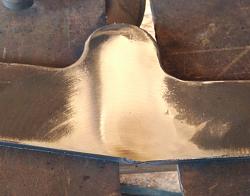
this is the edge where you would see the weld if stick electrodes were used
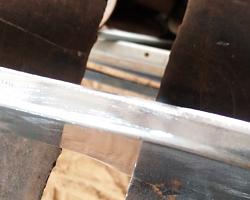


 LinkBack URL
LinkBack URL About LinkBacks
About LinkBacks

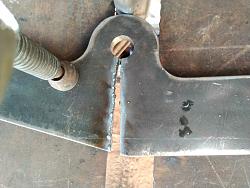
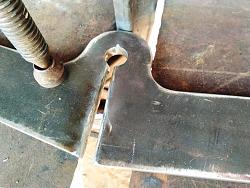
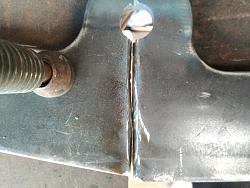
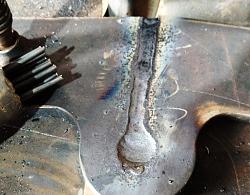
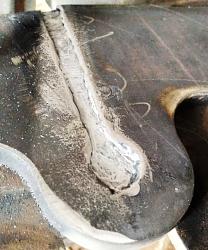


 Reply With Quote
Reply With Quote




Bookmarks